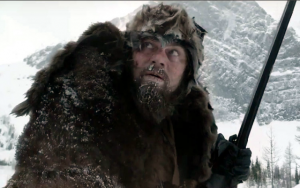THE REVENANT: 4 STARS. “sure to spark conversation as closing credits roll.”
 The last time we saw Leonardo DiCaprio he was driving a Ferrari and picking up $26,000 dinner tabs. “The Wolf of Wall Street” star is back on the big screen in “The Revenant,” but now the fancy cars have been replaced with horses, the dinners with raw bison meat.
The last time we saw Leonardo DiCaprio he was driving a Ferrari and picking up $26,000 dinner tabs. “The Wolf of Wall Street” star is back on the big screen in “The Revenant,” but now the fancy cars have been replaced with horses, the dinners with raw bison meat.
Very loosely based on real events, DiCaprio plays American fur trapper Hugh Glass, a frontiersman who became a legend when he trekked across country after a brutal bear attack. In the film it’s 1823 and Glass is scouting for a team of fur trappers. The territory is tough, the men even tougher. When Glass is mauled by a bear the company splits into two groups. The first, lead by Andrew Henry (Domhnall Gleeson) heads for home base, while the other—Glass’s son Hawk (Forrest Goodluck), hotheaded trapper John Fitzgerald (Tom Hardy) and the inexperienced Jim Bridger (Will Poulter)—is paid handsomely to stay with Glass, and provide a decent burial when he succumbs to his injuries. Fitzgerald, more interested in getting paid than waiting for Glass to die, hurries the process along, stabbing Hawk and throwing the half dead scout into a hastily dug hole. When Glass comes to he has just one thing on his mind—revenge. “I ain’t afraid to die no more,” he says. “I done it already.”
This is Leo’s “Jeremiah Johnson,” a movie that masks his matinee idol good looks with facial hair and grimaces. His journey is at the heart of the movie but he shares the weight of carrying the film with Hardy. For much of the two-and-a-half-hour running time DiCaprio is mute, alone on screen crawling across the frozen landscape, slowly making his way toward Fitzgerald and his proposed revenge. There are great physical demands made on the actor—the Bear-Maul-O-Rama being just one of the miseries he endures—but this is an internal performance. The character’s strength, pain, frustration, anger and intestinal fortitude are apparent not only in his actions—he cauterizes wounds with gun powder!—but, more importantly, in his eyes. There’s the will to survive and then there’s whatever is driving Glass and whatever that is, it’s written on DiCaprio’s face. It may not be his flashiest role—although he does get to disembowel a horse—but it is one of his best.
Hardy’s Fitzgerald is painted in broader strokes. Driven by greed, this guy makes Bane look as morally bankrupt as Mary Poppins. Intimidating and ruthless, Hardy is a force of nature equal to anything Mother Nature places in Glass’s way.
Perhaps the “The Revenant’s” most complex character is Will Poulter’s Jim Bridger. He’s the runt of the litter, the youngest member of the expedition. Torn between loyalty to Hawk and Glass, his responsibility to his employers and his moral obligations, he is trapped in an impossible situation. Poulter pulls it off with a mix of steely determination and vulnerability.
“The Revenant” is the cinema of misery on screen and off. I’d suggest theatre-goers wear a sweater because the sense of cold and discomfort experienced by Glass is palpable.
On screen the primal story of revenge spares nothing to illustrate the hardships faced by all involved but director Alejandro González Iñárritu hasn’t simply made a gruesome film for the sake of upsetting the audience. Instead, it’s a movie that ends in a question mark. Is Glass’s payback justified or a hollow mission? Iñárritu leaves that decision to the audience, and it is sure to spark conversation as the closing credits roll.
